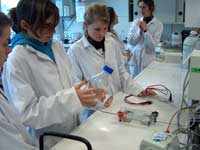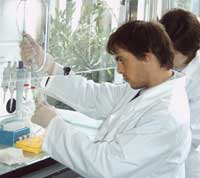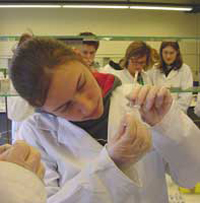Scientists@work Teach article
Teaching science in the classroom is all very well, but wouldn’t it be wonderful to let your students learn for themselves what it’s really like to work in a research laboratory? Sooike Stoops from the Flanders Institute for Biotechnology (VIB), Belgium, describes a project that does just…

Science as it is taught at school is often limited to theoretical explanation. Nevertheless, experiments, discoveries and testing new methods are a major part of scientific practice. But what secondary school has a fully equipped laboratory with the latest materials, tools and expertise? The creative solution may seem obvious, but unique in Europe: take a team of youngsters and their teacher to work in a professional lab with scientists who absorb them into their working day and involve them in their ongoing research! This is the formula of scientists@work.
The project is aimed at students (aged 14 and above) and their teachers in secondary education. The emphasis lies on practical experience, contact with professional scientists, involvement in ongoing research, and long-term interaction.
The project
Choose your own project

A group of up to 15 students and their teacher come to a working research lab for one day. The visit could be to a research institute, company, university or college (‘Hogeschool’ in Dutch) laboratory in Flanders (Belgium). They can choose from the list of participating projects that appears on the scientists@work websitew1. All these projects have been proposed by the scientists themselves, who invite the students to experience a day in the laboratory and to experiment together with them. This gives the students a very good idea of the research that scientists do every day.
In September 2006, students could choose between 68 different projects. Some examples:
- Research on leptin, a key molecule in the regulation of body weight
- How safe is our water?
- Looking for genetic defects in patients with mental retardation
- Nanobodies: invisibly small, but with a huge impact on medical science
- Researching the increase of yield in genetically modified plants
- Pollution and health: will everybody develop cancer?
- Our blood: a wealth of information
- RNA interference in Caenorhabditis elegans: how do you determine the function of a gene?
- Gene-expression analysis using the polymerase chain reaction (PCR)
- Zebrafish genetics: looking for new cancer therapies
- What can we learn from fly brains? Something about our own brain?
The diversity of the topics gives every group the opportunity to pick a project that is really of interest to them. Some of the projects submerge the students in the latest technologies, such as gene therapy, RNA interference and nanobodies.
The projects are then assigned to the different participating teams.
A day in the lab
Enthusiastic scientists show the tricks of the trade to 14- to 18-year-old students and guide them through their first steps in scientific research. They conduct experiments together that the scientists normally use for their daily work. These life-science experiments differ from project to project, depending on the topic. Some techniques may appear in several projects, like PCR, ELISA (enzyme-linked immunosorbent assay), DNA electrophoresis, and so forth. The guiding scientists tell the youngsters about what their lab is working on and about their own projects in particular. Often, a guided tour follows.

A written report
Afterwards, the students are obliged to submit a report on their experimental work to VIB, the organisers of scientists@work. In this final project from the entire group, the students have to place their work in a social context and in the context of previous and ongoing research in the field.
The youngsters often work for weeks on the final report. Sometimes they renew contact with their host scientists for additional information and they search the Internet for examples or for leads to further research. We also encourage them to contact foreign scientists who are conducting similar research. The scientists@work websitew1 presents brief biographies of scientists who are willing to give students background information on different research topics. Once their report is submitted to VIB, the teams automatically participate in the competition.
The final event
A jury selects the 10 best reports. All jury members have a scientific background and are actively engaged in science and science education, whether as teachers, scientists or science communicators. They judge the reports on scientific accuracy and clarity. They also pay attention to the level of effort made by the class: is it a report in the students’ own words, or did they copy and paste the information from another source?
The 10 chosen laureates present their work at a final event in the impressive Aula of Ghent University. The scientists who have been guiding the students introduce their team to the public. Each team presents a poster about its project in the exhibition area. In addition, they have seven minutes to present their project with the aid of a brief PowerPoint presentation, and then respond to questions from the jury. This professional jury selects three winners from the 10 finalists.
Prizes
All the participants of scientists@work receive a memento of a handy rucksack. In addition, the three winning groups receive wonderful prizes: first prize is a five-day trip to Ireland, second prize is a two-day trip to the Ardennes in Belgium, and third prize is a voucher for books or CDs. Both prize trips include a visit to a biotechnological company or research institute.
Scientists@work in figures
The project started in 2003–2004 with 37 scientists supervising 79 teams (about 800 students). Since then, scientists@work has grown and in the fourth round (2006–2007), 181 scientists offered 181 teams (almost 2000 students) a day in the lab.
From the two last rounds, it is clear that scientists@work is now a fixture in the world of biology education in Flanders.
The secret of success
The success of the initiative lies in the combination of two major components: hands-on experience in a lab, and a contest. The competition motivates the youngsters to participate and to do their utmost. For many students, this added motivation is all it takes to get them involved, whereas the chance to use high-tech equipment provides an initial fascination for others.
After the experience in the lab, the students discuss their experiments and ideas with each other, the teacher, and the supervising scientists, arriving (without necessarily realising it) at scientific analysis. This proves to be a very strong motivational experience, stimulating interest in science in young people in a way that is very hard to achieve in a normal classroom situation.
Scientists@work is not only an instructive experience for the youngsters, but also an excellent way to fill teachers and scientist supervisors with enthusiasm. The teachers see it as an ideal way to attend a training session (an opportunity that is not often available to them). And the scientists are impressed by the interest and motivation of the groups that visit them.
Scientists@work = more scientists?
At 14 years old, you may already have a preference for a particular course of study: science, technology, languages and so on. But whether you will actually choose a (biological) scientific subject to study at university remains to be seen. For a number of students, participation in scientists@work has been the stimulus for choosing to study biology or bioengineering. The majority of participants in scientists@work will perhaps go on to study something else. Still, they have experienced what it means to ‘do scientific research’. And that’s important too, because it enables us to become well informed citizens who allot scientific research its rightful – important – place in our society. Even today, research too often restricts itself to the tall ivory towers and hopeful news articles. Understanding how cells and organs function, and how diseases originate and can be cured, helps youngsters to put (life) sciences in the right perspective. At the same time, by steeping themselves in these things for a day, students also notice that the path of the scientist is not always strewn with roses.
Spreading the idea…
If you would like to set up a similar project in your own country, the scientists@work organisers are happy to offer advice. Contact Sooike Stoops (sooike.stoops@vib.be).
Case study
Twenty-four enthusiastic youngsters and their science teachers, from the Heilige Familie school in Sint Niklaas, were invited to Bayer CropSciences in Astene (near Ghent, Belgium) for a scientists@work project related to RNA interference: ‘how can we switch off genes?’.
The host scientists prepared a very good introductory slide show explaining the principles of RNA interference and introducing the experiments for the afternoon. We heard some information on what a company like Bayer CropScience is actually doing. For the practical work the students were divided into two groups: 12 students in the laboratory ran their first ‘gel’ ever to isolate DNA and RNA from tobacco leaves, and the other 12 students gathered in the greenhouse to count phenotypes of cold tolerance, male sterility and so forth. The scientists from the company were very helpful in answering all our questions and the exchange of experiences of both groups was stimulating as well.
In the days and weeks to follow, students and teachers worked hard to put their experiences on paper. No wonder we were all so excited when our work was listed in the top 10 of all scientists@work experiences. Lots of stressed moments followed preparing the slide show and no less during the presentation and the jury’s questions, but we did it: we finally ended up as number one! What a great experience and definitely a perfect way to get an impression of ‘real-life’ scientists. Some of us just needed this last push to become convinced of our choice to continue into science.
Lieve Ongena, teacher
Web References
- w1 – All relevant information on scientists@work is available here. This main site is in Dutch, but a summary in English is available here.
- Scientists@work is a school project of VIB (the Flanders Institute for Biotechnology).
Review
This article describes a brilliant idea and a successful method to introduce students to the realities of the working day of modern biology researchers: students, accompanied by a teacher, spend a day working with a research scientist in an authentic research laboratory environment. It is a productive, yet relatively simple process, and can be applied to any country with even the smallest biological research laboratory.
The information provided in the article can inspire interested scientists to organise similar projects in other science disciplines. For example, chemistry teachers might consider programmes that involve pharmaceutical companies or other major chemical labs. Also, it shows how to take advantage of competitions to attract students’ interest and motivate them to participate in projects that will help them learn about science.
Projects like scientists@work not only serve to stimulate interest in science in young people and to potentially ‘recruit’ future scientists but also emphasise a number of other important issues that relate to scientific research, including: its true value in our life and its impact on society, its nature as an endeavour that requires communication and collaboration among scientists across borders, and the fact that it is not a secret kept hidden from the general public. Furthermore, such projects benefit everyone involved: students, teachers and research scientists.
Michalis Hadjimarcou, Cyprus





